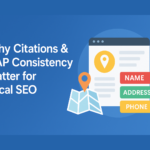- July 3, 2025
- Categories: SEO
- Tags:
Mobile SEO Strategies: How to Optimize for Mobile Search in 2025
With over 60% of all web traffic now coming from mobile devices, optimizing your website for mobile isn’t optional, it’s essential. In 2025, Google continues to use mobile-first indexing, meaning your mobile site is the primary version Google considers when determining your rankings.
That’s why you need strong mobile SEO strategies, not just responsive design, but a full spectrum of optimization techniques that ensure your content performs well on smartphones and tablets. In this guide, we’ll walk you through the most effective SEO strategies for mobile devices that enhance both user experience and search engine visibility.
What Is Mobile SEO?
Mobile SEO refers to the process of optimizing your website to ensure that it ranks well and functions seamlessly on mobile devices. It involves improving elements like site speed, responsive design, user interface (UI), and content formatting so that mobile visitors get the best possible experience.
It’s not just about appearance, Google actively penalizes mobile-unfriendly sites, and even small issues (like hard-to-click buttons or slow loading times) can result in lower rankings and higher bounce rates.
Top Mobile SEO Strategies for 2025
Let’s explore the most effective SEO strategies for mobile devices to ensure your site is optimized for today’s users.
1. Responsive Web Design
A responsive website automatically adjusts to different screen sizes, providing a seamless experience whether users are on a phone, tablet, or desktop. Google strongly recommends responsive design because it uses a single URL and codebase, making it easier for search engines to crawl and index.
Action Tip: Use fluid grids, flexible images, and CSS media queries to create layouts that adapt perfectly to various screen sizes.
2. Improve Mobile Page Speed
Mobile users are impatient. If your page takes more than 3 seconds to load, most users will leave, and Google knows this. Page speed is a direct ranking factor, especially for mobile searches.
Action Tip: Compress images, enable browser caching, use a Content Delivery Network (CDN), and minimize JavaScript to reduce load times.
Tools to Use: Google PageSpeed Insights, GTmetrix, Lighthouse
3. Mobile-Friendly Navigation
Mobile screens have limited space, so navigation must be simple, thumb-friendly, and clutter-free. Use clear buttons, hamburger menus, and sticky headers to enhance usability.
Action Tip: Keep menu items minimal, use large tap targets, and avoid complex dropdowns on mobile.
4. Optimize for Voice Search
Voice search is growing rapidly, and many queries come from mobile users using tools like Siri, Google Assistant, or Alexa. To optimize for voice, you need to use conversational keywords and natural language queries.
Action Tip: Create FAQ-style content, include long-tail keywords, and use schema markup to help search engines understand your content contextually.
5. Use Mobile-Optimized Content Structure
Mobile users scan quickly. That means your content should be:
- Short and to the point
- Broken up into smaller paragraphs
- Enhanced with bullet points, bold text, and subheadings
- Supported with visuals like infographics or icons
Action Tip: Format content for readability, especially on smaller screens, and make sure it doesn’t require zooming or excessive scrolling.
6. Enable Accelerated Mobile Pages (AMP)
AMP is a framework developed by Google to create super-fast-loading pages for mobile users. While not essential for every site, it’s beneficial for blogs and news content that rely on visibility and speed.
Action Tip: Use AMP if your site is content-heavy and you want near-instant load speeds. Be aware that it limits customization.
7. Mobile Specific Schema Markup
Schema helps search engines understand your content and improve your search snippets, especially on mobile devices where space is limited. Implement schema types like:
- FAQ schema
- Product schema
- Article schema
- Local business schema
Action Tip: Use tools like Google’s Structured Data Markup Helper or Rank Math/Yoast SEO plugins to add schema easily.
8. Avoid Intrusive Pop-Ups and Interstitials
Pop-ups that block mobile content are frustrating and can hurt your rankings. Google penalizes mobile sites that use intrusive interstitials that make content hard to access.
Action Tip: Use non-intrusive banners or slide-ins instead of full-screen pop-ups on mobile devices.
9. Test Mobile Usability Regularly
Mobile optimization is not a one-time task. Use tools like:
- Google Mobile-Friendly Test
- Google Search Console (Mobile Usability Report)
These tools help you identify broken layouts, text size issues, or elements that are too close together.
10. Mobile Link Building Strategy
While traditional link building applies to all devices, you can boost your mobile SEO by getting featured on:
- Mobile-first publications
- Responsive blogs
- Apps or mobile-specific content aggregators
Also, make sure that your landing pages being linked to are mobile-optimized, so that any earned traffic converts effectively.
Mobile SEO Is No Longer Optional
As mobile usage continues to rise, search engines prioritize websites that deliver an excellent mobile experience. If your site isn’t optimized for smartphones, you’re not just missing out on rankings, you’re losing users, conversions, and credibility.
Implementing strong mobile SEO strategies will help you:
- Improve mobile rankings
- Reduce bounce rates
- Increase time-on-site
- Drive better engagement and conversions
Whether you’re running an eCommerce store, a SaaS platform, or a blog, mobile SEO is a must-have part of your strategy in 2025 and beyond.
Ready to Make Your Website Mobile-First?
Our team helps businesses create fast, mobile-optimized websites that rank and convert. Let’s audit your mobile SEO and unlock your site’s full potential.




